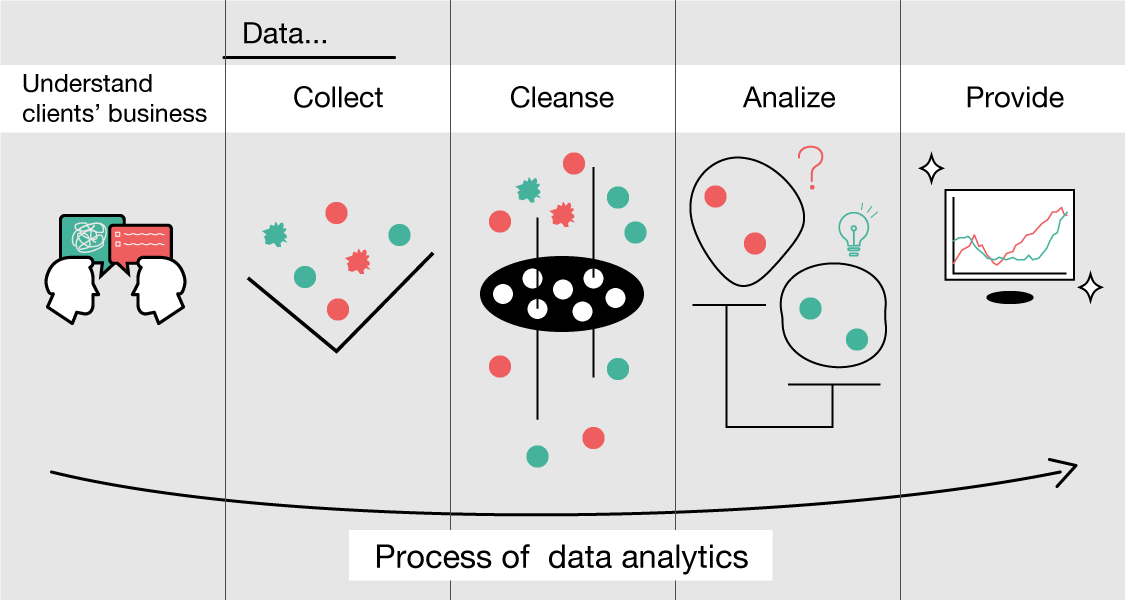MTI Journal
MTI Journal.16
Data Analytics Starting from Communication with Users
Haruna Yoshida
Researcher, Maritime and Logistics Technology Group*
*The job title is as of February 3, 2021
In October 2018 I was seconded to MTI and have since been engaged in data analysis, solution development, and such. At NYK I had worked in the operation of coal carriers and the budget management and sales of car carriers. At MTI, a research institute owned by a shipping company, a relation unique in the world, I utilize the business know-how learned at NYK while working every day on R&D in consideration of being close to our customers.
The maritime industry has a wide variety of available data: data acquired from sensors built into equipment such as engines, various data related to voyages and cargoes, metocean data, and so on. By utilizing all that data, we can contribute to safe and stable transportation services.

What Is AIS Data?
Currently, I deal with AIS data every day in R&D. Although just part of the big data in the maritime industry, AIS data is attracting worldwide attention, the subject central to much active academic research and many journal articles.
The term AIS is an abbreviation for Automatic Identification System. By international treaties, the system must be installed on certain ships to prevent collision and ensure the safety of human life. It automatically sends and receives ship-safety information such as ship types, positions, and courses. The information is exchanged via VHF radio waves between ships and land. So if, for example, a ship is approaching land, AIS plays an important role in the safe navigation of all ships, such as by calling attention from the land and providing weather information to ships from the land.
How to Deal with Big Data
It is important to figure out how to accumulate the data and build an infrastructure for handling it within the company, as the total amount of data, not only AIS data but also the whole of big data, is enormous. In addition, data is incomplete. We are considering the database structure with an eye to future usability, removing duplicated or abnormal values, and linking data systems.
Recently, we have more and more requests for utilizing BI tools*1 or analyzing AIS data from PICs in sales departments. I believe that it is important for continuous data utilization to listen to user voices continuously and consider the solutions.
What Is Data Analytics?
Data analytics is often likened to cooking. First, we buy ingredients (collect data), then prepare them (cleanse the data), then cook them (analyze the data), and finally serve the dishes (provide the data). It is said that 80% of the time needed for these data-analysis processes is spent collecting and cleansing data – five-star dishes need careful preparation.
Before actually collecting data, there is also a necessary step, which is clarifying what clients want to do with data analysis and the purpose. Therefore, I try each time to carefully check what their trouble is and what kind of analysis is suitable for solving the problem. In many cases, the troubles are not clear, so it is important to clarify the near-term purpose and long-term goal while listening to their story.

In the AIS-data-related project, we are researching the creation of a mechanism to improve ship procurement, ship allocation, and cargo combination – all using a new analytic method different from the conventional method, utilizing it for market forecasting. The goal is not only to accurately predict market conditions but also to let users use the forecast results. To make the best use of market forecasts in practice, we have adopted a white-box approach that is easier for everyone to understand than a black-box approach represented by neural networks in AI. We are conscious of both analyzing the data and utilizing it.
How to Utilize Technologies
We are working on R&D not only for data analysis but also for technologies as a whole, assuming the scenes actually used by users. Still, every day, I feel the difficulty of developing something that people can actually use.
Honestly, when I was at NYK I didn’t fully understand all the technologies that my company owned and was satisfied with just having them rather than using them. But then I came to MTI, to the forefront of technology development, and am now engaged in R&D projects. Yet I remember how my boss at NYK had often stressed “the importance of imagining the actual sites.” And although there are many areas where I can make good use of the practical operational know-how, there are also areas where I cannot lead well enough just because I know the actual business.
At such times, through interviews and observations of business practices, I try to find breakthroughs by gaining insight into events and discovering problems that the person is not aware of – all without being caught up in what the person is saying or the common sense of the department. Since what we develop will eventually be used by people, we value communication with people in any situation and take clients’ problems as our own; hopefully, I can lead them while overcoming many small mistakes.
Toward the Creation of Innovation
In a world full of buzzwords, we often hear the term innovation, one theory of which sees it as an augmentation of some already existing knowledge, for example, as when new business models, products, and services are created by combining the knowledge of our existing business model with other knowledge such as methods used by other companies in other business areas. For that, it is necessary to expand the range of knowledge by trying various combinations of knowledge. In business administration, this is called exploration. Innovation is essential if we are to continue providing higher added value. Therefore, I feel it is essential that I keep my eyes open and catch trends in any area, in shipping or transportation or not, and cooperate with partners who have the same will.
As MTI members come from various backgrounds, mainly in the shipping industry, such as shipyards and marine equipment manufacturers, and as open collaboration is being actively promoted, the environment is ripe for exploration and innovation. And by giving back to NYK this experience of facing clients’ troubles and spawning innovations, including through trial-and-error processes involving partners, we hope to bolster the NYK Group’s aim of creating innovations making the world a better place.
*1 BI (business intelligence) tools: tools used for visualizing data by graphs or creating formatted reports or dashboards.
